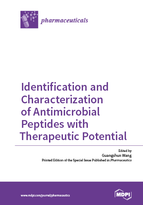Identification and Characterization of Antimicrobial Peptides with Therapeutic Potential
A special issue of Pharmaceuticals (ISSN 1424-8247).
Deadline for manuscript submissions: closed (30 December 2013) | Viewed by 174896
Special Issue Editor
Interests: host defense antimicrobial peptides; structural bioinformatics; biomolecular NMR
Special Issues, Collections and Topics in MDPI journals
Special Issue Information
Dear Colleagues,
Pharmaceuticals has initiated a collection on antimicrobial peptides (AMPs). The main theme is “Identification and Characterization of Antimicrobial Peptides with Therapeutic Potential”. During 2013-2014, the journal published several articles that discuss AMPs from amphibians, birds, insects, fish, reptiles, humans, fungi (under review), and plants (ongoing). We thank authors for their contributions. The journal would like to continue this interesting topic and you are encouraged to submit review articles, original articles, and communications on AMPs. Review articles that summarize AMPs from other life domains (bacteria, protozoa, mollusca, worms, spiders, and so on) are especially welcome. In addition, original articles that report novel AMPs (natural or engineered) are also invited.
Dr. Guangshun Wang
Guest Editor
Manuscript Submission Information
Manuscripts should be submitted online at www.mdpi.com by registering and logging in to this website. Once you are registered, click here to go to the submission form. Manuscripts can be submitted until the deadline. All submissions that pass pre-check are peer-reviewed. Accepted papers will be published continuously in the journal (as soon as accepted) and will be listed together on the special issue website. Research articles, review articles as well as short communications are invited. For planned papers, a title and short abstract (about 100 words) can be sent to the Editorial Office for announcement on this website.
Submitted manuscripts should not have been published previously, nor be under consideration for publication elsewhere (except conference proceedings papers). All manuscripts are thoroughly refereed through a single-blind peer-review process. A guide for authors and other relevant information for submission of manuscripts is available on the Instructions for Authors page. Pharmaceuticals is an international peer-reviewed open access monthly journal published by MDPI.
Please visit the Instructions for Authors page before submitting a manuscript. The Article Processing Charge (APC) for publication in this open access journal is 2900 CHF (Swiss Francs). Submitted papers should be well formatted and use good English. Authors may use MDPI's English editing service prior to publication or during author revisions.
Related Special Issues
- Microbial Biofilms in Pharmaceuticals (8 articles)
- Antimicrobial Peptides: Expanded Activity Spectrum and Applications in Pharmaceuticals (8 articles)







